The Yamnuska Wolfdog Sanctuary guarantees an unforgettable experience that’s bound to imprint a paw on your heart. It is a haven for rescue wolfdogs, giving them a chance at a life filled with care.
In this adventure, you’ll get a chance to walk among the wolfdogs. Your visit to Yamnuska is more than a day out – it’s a chance to connect and learn about these beautiful animals.
If you’re spending time in the Canadian Rockies and were hoping to see a wild wolf, you’ll have to get extremely lucky. But, you can do the next best thing and interact with wolfdogs by adding a visit to Yamnuska Wolfdog Sanctuary to your list of things to do near Banff National Park.
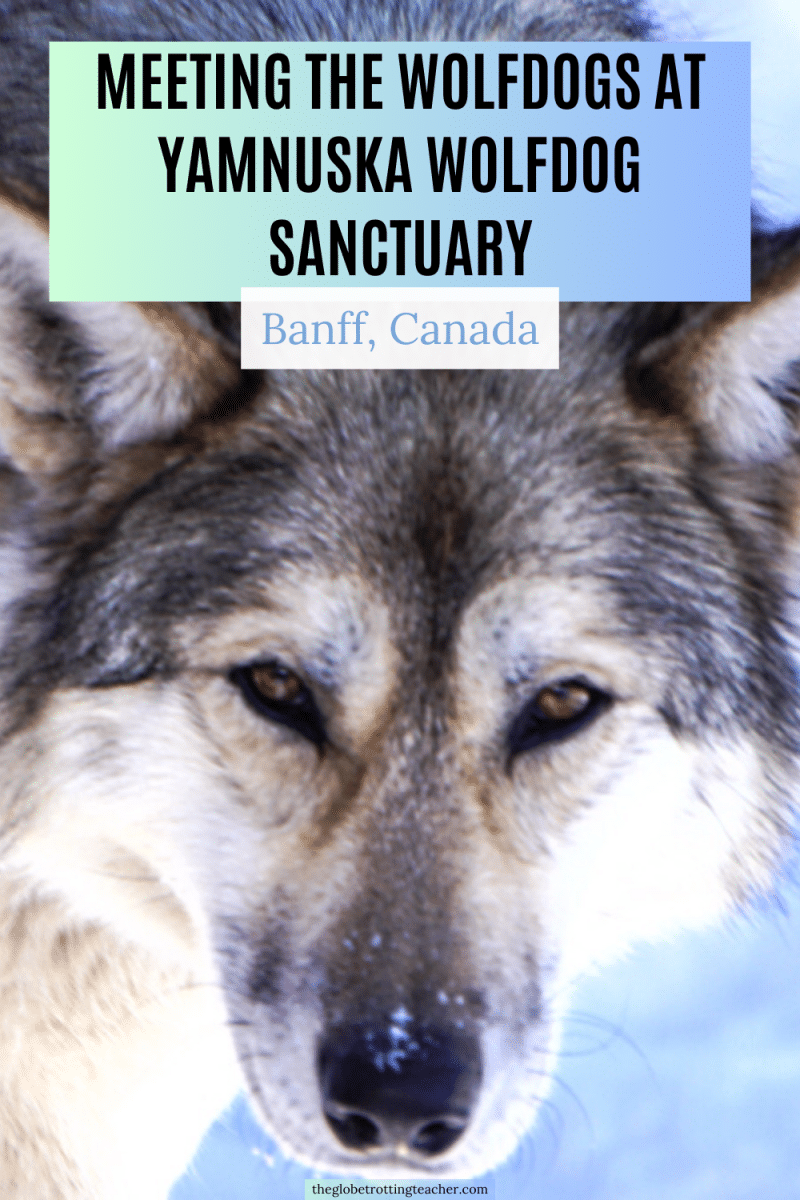
What You Need to Know About the Yamnuska Wolfdog Sanctuary
The Yamnuska Wolfdog Sanctuary is a non-profit organization that takes in rescued wolfdogs, from the high content wolfdog to the low content wolfdog. These are wolfdogs who have been otherwise neglected, displaced, surrendered by their owners, or abandoned.
Located an hour east of Banff, Yamnuska Wolfdog Sanctuary in Cochrane, Alberta Canada offers visitor tours where it’s possible to walk through the sanctuary and even interact with the wolfdogs.
Along the way, a knowledgeable guide explains the differences between wolves, wolfdogs, and dogs, as well as why wolves are so important in the wild landscape.
This non-profit sanctuary is a safe haven for rescued wolfdogs, 43 permanent wolfdogs currently, including 10 ambassador wolfdogs that you’ll get to meet during the tours and activities.
The sanctuary is run by a group of animal lovers with the goal of spreading awareness about responsible wolfdog ownership. They offer tours and educational programs that provide visitors with a better understanding of wolfdogs’ unique nature.
About the Wolfdogs at the Yamnuska Sanctuary
If you’re someone who has dogs for pets, you may have looked at your cute, cuddly fur-baby and wondered how on Earth it’s possible this loveable little creature descended from wolves.
Certainly, a lot of history and genetics have happened over a long period of time to where we now have everything from Italian Greyhounds (my babies!) to Labradoodles.
However, the wolfdog, by definition, is a hybrid between a domestic dog and a species of wolf.
These amazing animals fall into somewhat of a gray area. On the one hand, breeders sell (supposed) wolfdog puppies, while laws in many places classify them as a wild animal and/or prohibit them from being kept as pets.
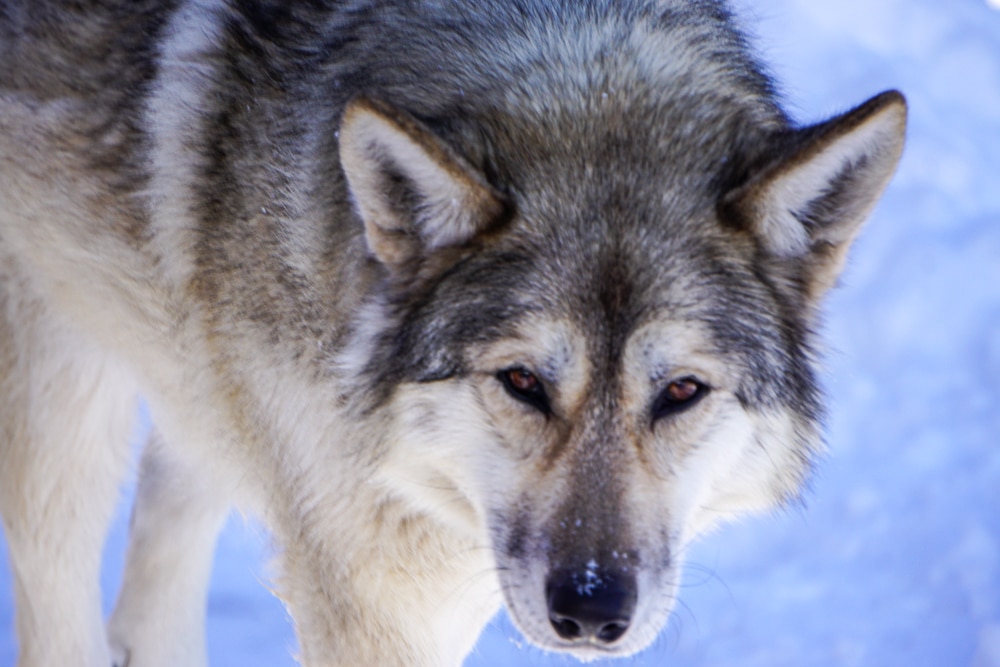
The result is the need for a place like Yamnuska. Either owners are prevented from keeping their wolfdogs or realize their cute puppy has grown into a pet not suited to their lifestyle and/or is aloof and difficult to manage.
So, I was glad to have booked an interactive tour to learn more about wolves, wolfdogs, and dogs, not to mention, the opportunity to get up close with the wolfdogs themselves.
What are the Different Types of Wolfdogs?
Meeting the Wolfdogs at Yamnuska Wolfdog Sanctuary
With Alberta’s open-expanse between Calgary and Banff in the foreground and the looming peaks of the Canadian Rockies in the background, we pulled into the long driveway leading to the sanctuary. Black wolf silhouette placards lined the fencing. The air was crisp but the sky was bright blue. Stepping out of the car, the wolfdogs welcomed us with their howls.

Entering the main office, we were greeted by a large malamute. She greeted us by wagging her tail and nuzzling into our legs. We later learned just how dog-like this is, but at the time we didn’t know if she was dog or wolfdog, just enormously friendly!
The tour began just through the other side of this building where the wolfdog enclosures came into view.
With a center walkway leading to other smaller pathways, we noticed packs of 2-4 wolfdogs in large open pens. Yamnuska Wolfdog Sanctuary prides itself on having large 1-2 acre enclosures in a natural setting with carefully considered pack arrangements.
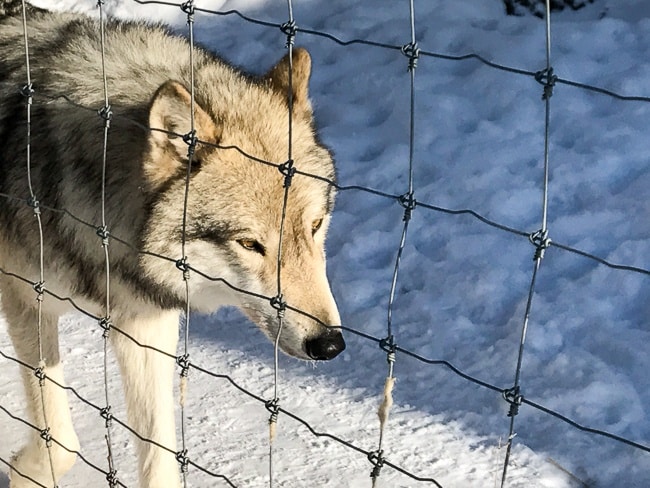
After going over a few dos and don’ts, the guide led us into a fenced-off pathway and into one of the enclosures with 3 high-content wolfdogs named Kuna, Zeus, and Nova. As our small group settled into a benched seating area, Kuna came to greet the guide while Zeus and Nova scattered to the far reaches of the enclosure.
Knowing how rare it is to spot a wolf in the wild, it was thrilling to see Kuna and the others in such close proximity!
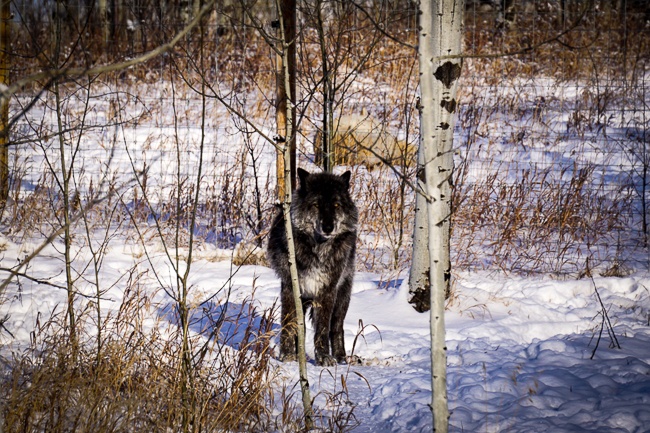
The tour guide gave us a handful of treats and began to explain what was meant by high content wolfdog. Kuna lingered near the guide for a few moments, perhaps thinking about the treats in our hands, but then retreated back toward the other 2 wolfdogs. It was still enough time to admire her hazel eyes, long legs, and coat of blended black, white, and golden brown hair.
The sanctuary uses a process called phenotyping to determine how much wolf or dog each wolfdog has in their blood. By observing physical features and behavior, a determination is made. So, high content wolfdogs look and act more like wolves than dogs.
I realized I’d never really noticed some of the truly distinctive features separating wolves from dogs, but as the guide explained it was easy to see the differences.
Their long legs set close together combined with a leaner frame were built for traveling long distances and speed. In addition, these wolfdogs were acting more like wolves, displaying their instinctive reaction to move away from people rather than seek them out for attention and affection.
Our guide walked up around the wolfdogs and tried to coax them closer with some treats. However, they weren’t interested and I was glad to see the guide respected their wishes.
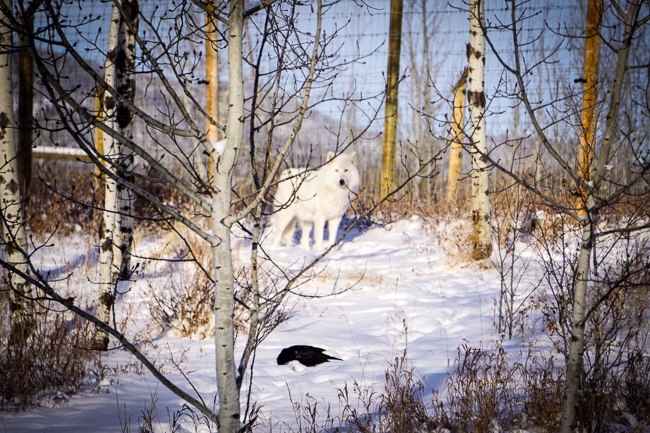
In fact, all through our visit, the sanctuary proved itself to be a safe haven for the wolfdogs and a place of education for the humans. The staff was incredibly caring and knowledgeable.
These are key signs your travel-animal experience is ethical and puts the animal’s interests first, above all else.
We gave Kuna, Zeus, and Nova their enclosure back and headed to another enclosure with 2 low-content wolfdogs named Loki and Nikki, and 1 upper mid content wolfdog named Rue. Not only were these wolfdogs more interested in us, Loki greeted us at the gate with his tail wagging, all but uttering the words “Hello” and “Welcome!”
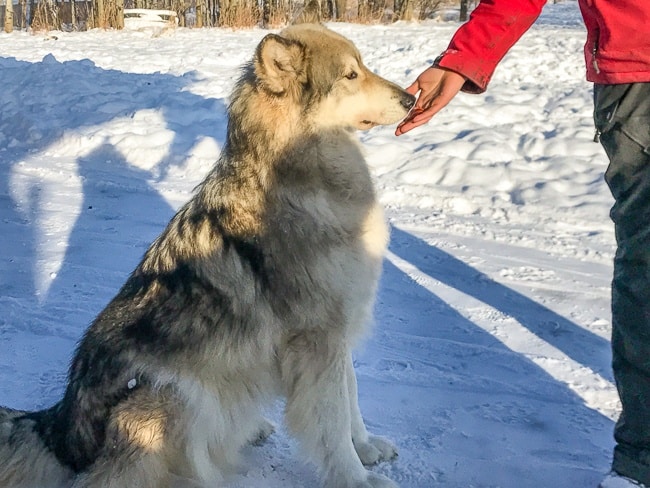
Once again seated, the guide pointed out the differences between these wolfdogs, compared to the ones we had just left.
Loki clearly adored the spotlight and went down the line of visitors for treats, allowed us to pet him, and even shook paws with us. Rue was a bit more hesitant but did selectively make her way over to say hi and take a treat. She was gentle and had loving eyes, but we stayed within her comfort level and did not reach out to pet her unless she wanted it to happen.
Seeing Rue, who is more wolf, and Loki, who is more dog, side by side made it really easy to see the physical characteristics and the levels of trust with humans that defined each one.
Wolves have been hunted by humans for centuries teaching them to distrust and run from us. While dogs, on the other hand, have learned to stay close to humans. These instincts played out in front of us like a biology lesson.
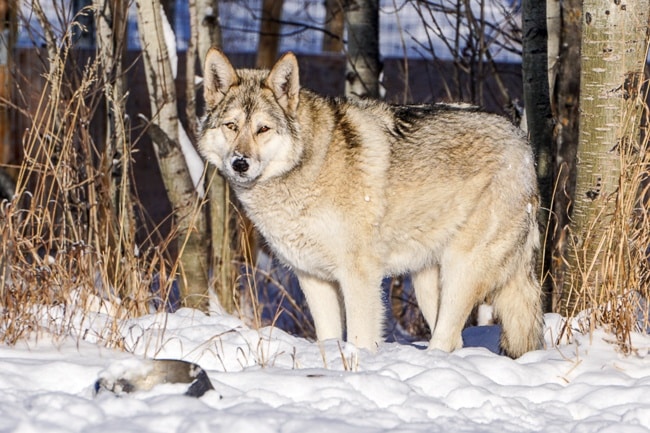
As the tour wrapped up, we said our goodbyes to the wolfdogs. We were able to freely wander the open pathways past other enclosures. Each one had signs with the wolfdogs’ names and content levels. There were also fact signs to teach more about wolves and wolfdogs.
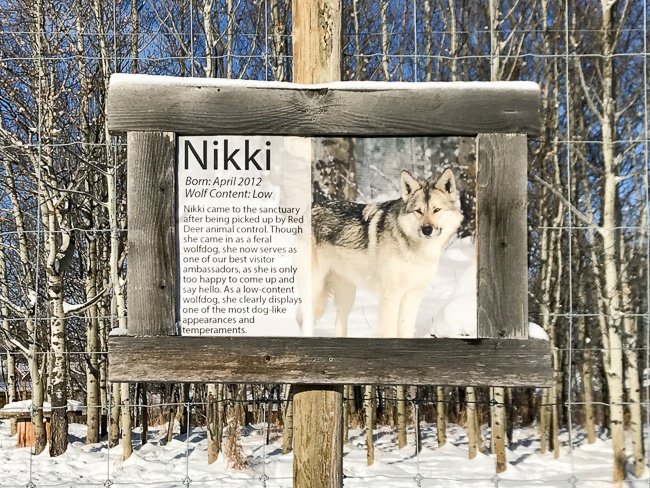
Toward the end of our visit, something stirred the wolfdogs and their howls echoed from all around the sanctuary. After all, dogs bark, but wolves howl. It couldn’t have been a more fitting finale to our up close, truly original wolfdog experience.
Planning Your Yamnuska Wolfdog Sanctuary Visit
The sanctuary is open all year round every Thursday-Monday from 10 am – 5 pm.
How to Get There
If you’ve rented a car no need to join a guided tour from the Banff area. The scenic 1-hour drive is straightforward and mostly along the Trans-Canada Highway. If you’re heading to Yamnuska from Canmore, the drive is about 40 minutes.
Tours Offered by the Sanctuary
There are 3 options for your visit. All money made from the tours and visitors goes toward the sanctuary’s continued rescue efforts.
The Sanctuary Walk is a self-guided walk along the open pathways of the sanctuary to view and read about the wolfdogs in their enclosures. You can explore the property at your own pace. No reservations are needed.
The Intro Tour is a guided walk through the sanctuary with one of the wolfdog experts. It is a more interactive tour than the Sanctuary Walk. Reservations are not required but large groups may want to confirm availability before making the drive.
The Interactive Tour (what I did) allows only 6 people per tour, so be sure to make advance reservations. A wolfdog expert will take you into the enclosures for an up-close experience to learn and interact with the wolfdogs.
Dress Code
Wear closed-toed shoes; no sandals or flip-flops. If your shoes have laces, tuck them in.
Avoid fur or faux fur clothing and accessories for safety. Don’t wear clothing or accessories with pompoms or dangling features that could be mistaken as a lure.
Lastly, make sure to dress in comfy clothes that suit the weather.
Other Things to Keep in Mind
- The sanctuary does have age restrictions for each tour so read the details of each visit option carefully. Either way, the wolfdog sanctuary is not right for children 5 and under.
- Keep it light when you visit the Wolfdog Sanctuary – the less you bring, the better. Just bring your phone or camera; leave the rest in your car.
- No food and drinks are allowed inside the sanctuary. But if you’re planning to enjoy your lunch in the area, there are picnic tables in the parking lot.
Exciting Encounters Await at Yamnuska Wolfdog Sanctuary
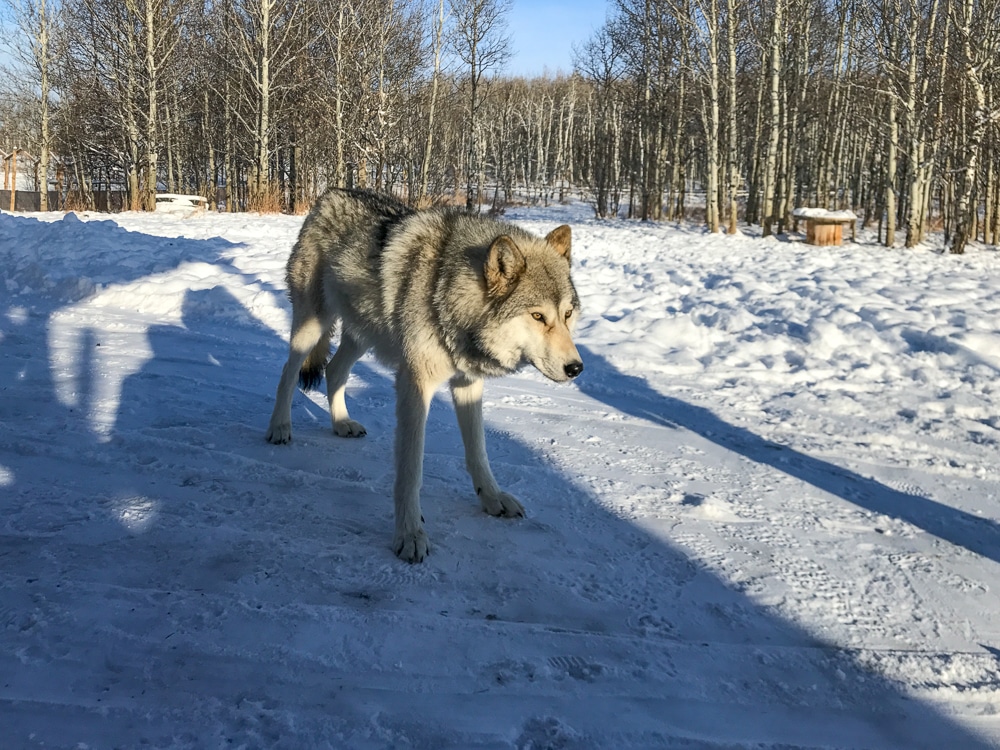
After spending a few hours at Yamnuska Wolfdog Sanctuary, animal lovers will not soon forget the wolfdogs’ golden eyes, instinctive howl, or what it feels like to get up close with nature’s closest genetic match to wolves.
Exploring the wolfdog sanctuary while in Banff is an experience that’ll surely leave a pawprint on your heart and is a great way to support the sanctuary’s important work. From the rescue tales to the thrill of walking among the wolfdogs, these memories will make you want to return to meet them again.
Would you like to meet the wolfdogs at the Yamnuska Wolfdog Sanctuary?
Like this post? Please share it on social media using the share buttons below.


